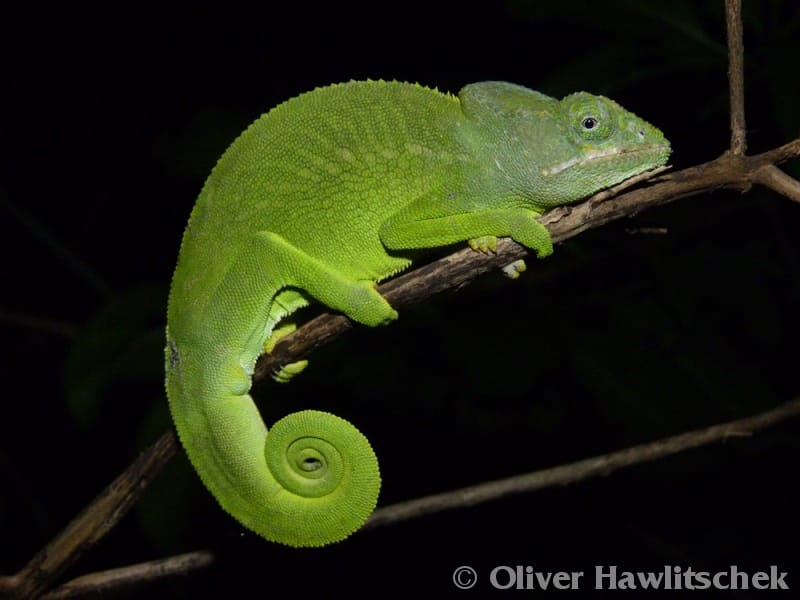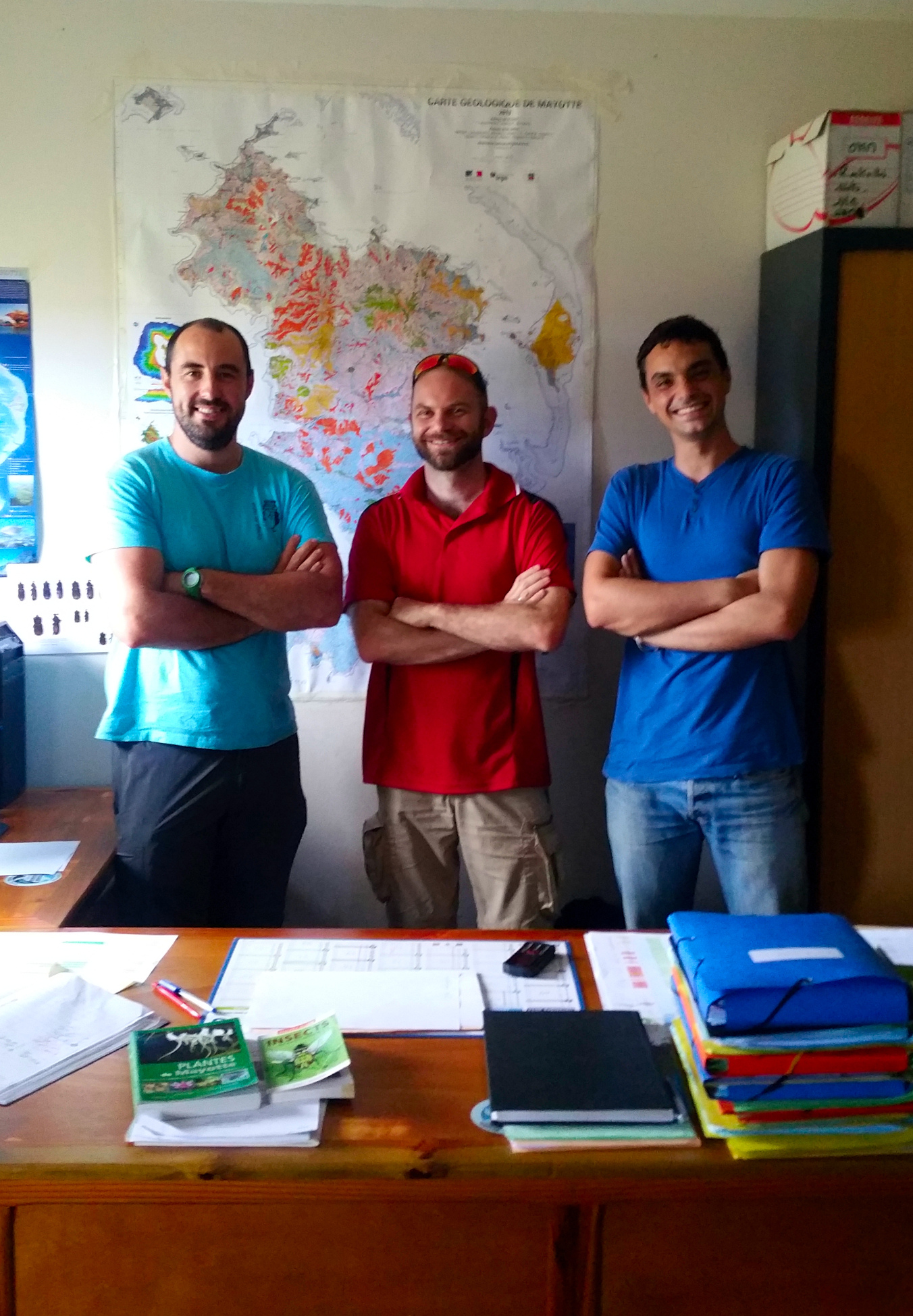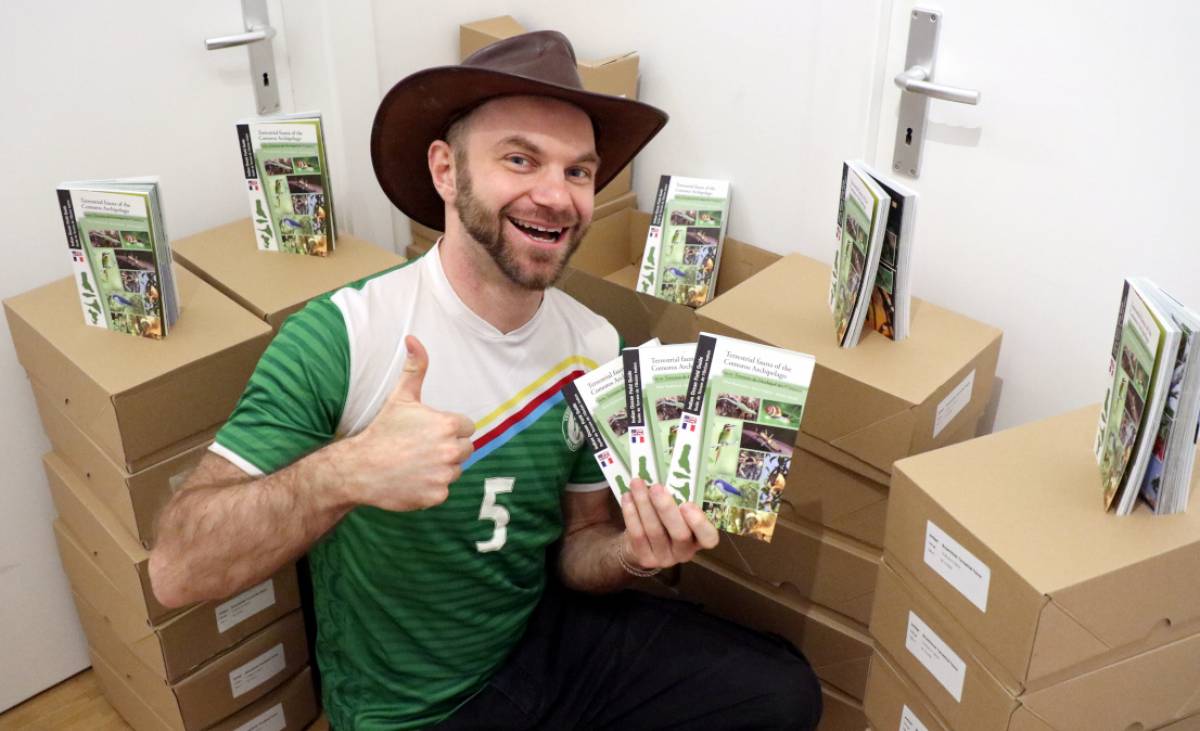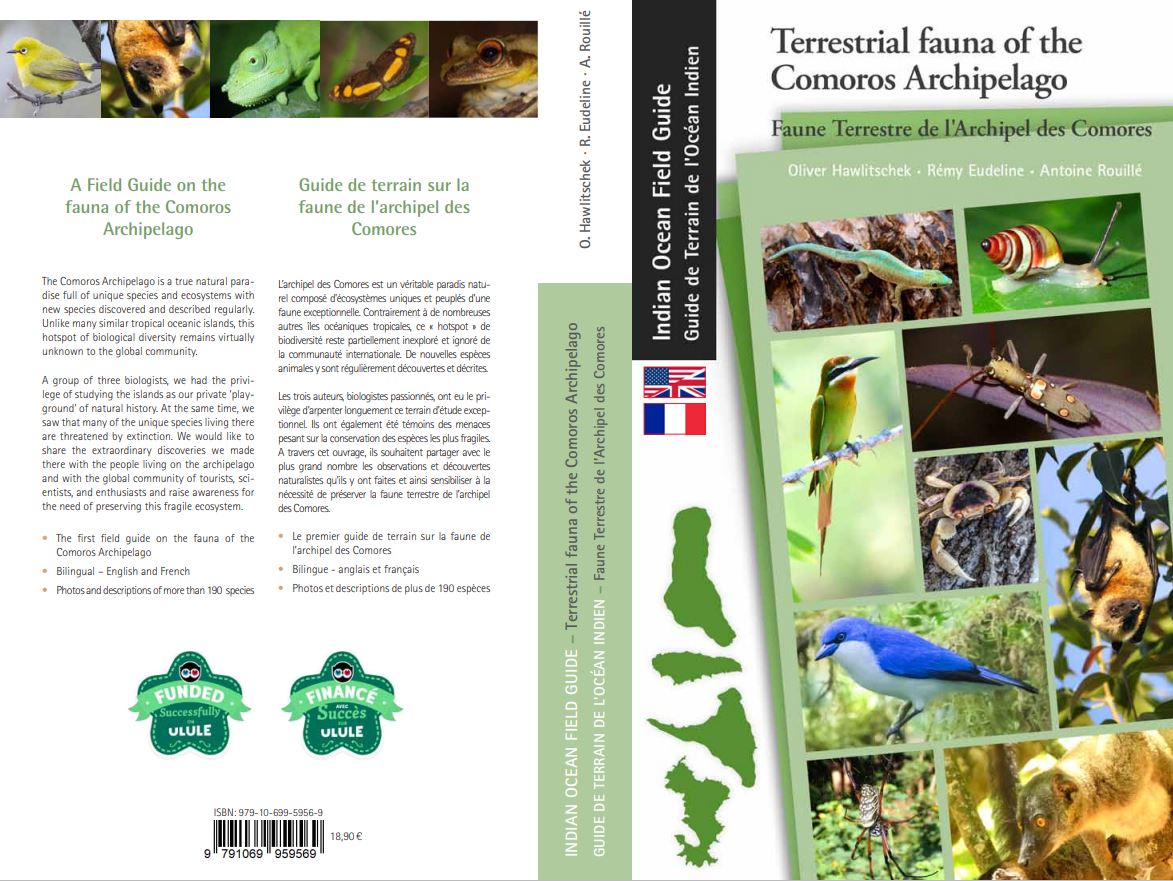1) Hi Olly, welcome! I usually only interview authors and other artists from the fantasy sphere. But since you do research about beings that are naturally fantastical, you fit perfectly into my blog. Thanks for taking the time! Tell us: What kind of beings are they, and what fascinates you most about them? How did you discover your passion for them?
Hi Karin, I'm happy you are making an exception for me. And I'm even happier to hear that you feel that the beings I work with are fantastical – I feel the same way. I have been fascinated by all animals, in fact, by all of nature, since my childhood, and it was clear to me all along (except for some short distractions during my adolescence) that I wanted to become a biologist. And that's what I’ve become! I think I'm neither extraordinarily talented nor smart, but I have always been extraordinarily enthusiastic – and that's what got me to where I am now.
Since my time as a student, the fauna of Madagascar and the Comoros, a group of volcanic islands near Madagascar, has been my main field of interest. Many unique species of animals and plants live there, but the Comoros remain poorly studied even today. This is why they were and are what I call my scientific "playground" and, by now, also something like my second home.
I'll allow myself to use a few humazining attributes in this context. The Comoros are a place where emerald green day geckos dash across violet banana flowers, in the shade of mango trees where fruit bats are literally 'hanging out' in the afternoon sun, squabbling softly like old neighbors. Sunbirds buzz from flower to flower like flying gemstones until night falls quickly and wolf snakes with huge cat's eyes emerge from their hideouts to sniff out chameleons sleeping in the branches of trees. I couldn't think of a more fantastical setting than this!

Furcifer polleni
2) What was the most recent thing you discovered? How and where did you make this discovery?
Our latest find is the nano-chameleon, which only grows to 13 mm as an adult male, making it the smallest 'higher' land vertebrate. There are only a few species of frogs that are even tinier. These all-time records are well received by the press, especially if they are also about sex: The male nano-chameleon's genitals measure 18% of its body length, which would correspond to 30.6 cm in a human of 170 cm. We think that this is an adaptation to the size difference between the sexes: Female nano-chameleons reach 19 mm, which is still tiny, but considerably larger than the males. This means that reproduction will only be successful with the adequate male anatomy.
We discovered the nano-chameleon back in 2012 during an expedition of several scientists and field assistants on a remote mountain in Madagascar. After that, it took us some time to verify whether this was really a new species. And then we had to draft a scientific description to allow the species to be formally recognized as new. This process typically involves molecular genetic and anatomical analyses and peer-review by other colleagues, which is why nine years passed between the discovery and its publication.
Today, virtually all such discoveries are a result of team effort, but it still feels very special to be the one who discovers an animal and realizes that it might be a new species. In the case of the nano-chameleon, it was one of our field assistants who found it. One of the species that I personally discovered is the Starry Ground Gecko of the Comoros. We gave it this name because of his jet-black color with brilliant white spots. These are special moments in my life that I will never forget.*
3) You gave some interviews on this, for the BBC World News, among others. Who was responsible for the outreach there, and how did the interviews come about? Did the interviewers contact you, or did you prepare a press release?
There is a kind of standard procedure that we run through when publishing our research. Our results are first (and foremost, from our point of view) published in specialized scientific journals. As soon as we are informed about the scheduled release date of any such publication, we draft a press release with the public relations department of one of the research institutes involved, sometimes also with the press office of the scientific publisher. On the release day we send the press release to press agencies. Apart from that, we authors post the results on social media, mostly Twitter (personally, I don't use Twitter, only Facebook). Depending on their interest in our results, media representatives may contact us. Since the work was done as a team, we often forward interview requests to each other among the group of authors. The hype lasted a full two weeks in the case of the nano-chameleon. Conversely, many scientific publications don't get any press attention at all. But I think that in times of a pandemic, there is a higher than usual interest in broadcasting good news, such as the discovery of new species.
4) Alongside all of this, your book "Terrestrial fauna of the Comoros Archipelago" (2020) was a long-term project of yours and your co-authors’. I'm very interested in your approach, and I'm sure many other authors will be, too. You deliberately chose not to involve the usual giant book retailers and took a different path. Tell us: How did you manage to do this? How did you publish your book? Why did you choose this approach?
We completely self-published the book and also managed the trade distribution mostly on our own. Obviously, there are pros and cons about this. At first, we contacted established publishers of the field, but then discarded the idea. We were able to do this because it was never our goal to earn money with this book, and none of us depended on the revenue from the sales. Mainly, we wanted to make our knowledge and our data available as widely as possible, which is also why we planned and produced the book as a bilingual English-French edition. We wanted to keep the retail price low to allow as many people as possible to buy the book. Our target group included students, as well as the people living in the Comoros, which is a very poor country. We also wanted to donate a number of books to NGOs working in the Comoros. None of the publishers with whom we negotiated would have accepted this. Some publishers even claimed that people will be more inclined to buy the book if the price is not too low. This may be true, but not necessarily for our target group; and personally, I do not support this policy. Instead, we ran a crowdfunding campaign on Ulule that earned us 4,000 EUR. In addition to that, the environmental department of Mayotte pre-ordered 250 copies. In the end, 550 books had been pre-ordered and our expenses for printing 1,000 copies had been covered.
After we had the book printed by a local printing shop for a surprisingly economical price, my apartment was filled with half a metric ton of boxes full of books. First, we had planned to simply offer the book on Amazon. Eventually, we decided against it due to Amazon's policy. I acknowledge that this is something we could only do because we were not dependent on a high number of sales. We made a contract of trade distribution with NHBS, British natural history book shop; and some local bookstores of the Indian Ocean Region ordered books from us. There were also some orders placed by people who learned about the book via the Facebook page. The crowdfunding campaign gained us a lot of attention there.
Print on Demand was never an option. First, we knew from the start that we would need at least a few hundred books. Second, we wanted a high-quality product and many color plates, which is difficult to achieve for a good price with Print on Demand. Our printing shop offered me first-class service and sent me examples to choose paper quality and printing options.
5) Were there any special challenges? If so, how did you meet them?
One of our biggest challenges was writing a bilingual book. My co-authors are both French and drafted their texts in French, which I then translated to English. In turn, I drafted in English and they translated my drafts. This resulted in many errors and inconsistencies and took many rounds of proofreading and editing to fix. Thanks again to everyone who helped us with this.
I believe that, had there been no pandemic, the book would not have been published in 2020, but much later. The work required fast communication among the three of us, but business trips and stressful times at our day jobs often made this difficult. After a busy day at work I could rarely motivate myself to also spend the whole evening or even the whole weekend typing on my computer to work on the book. In the spring of 2020, all three of us were working in home office, things at work were relatively quiet, and so we really made good progress.

The authors Rémy Eudeline, Oliver Hawlitschek and Antoine Rouillé
6) What has 2020 taught you? Would you recommend your approach to other people who are planning on publishing a book (of any kind)?
I am pretty sure that many book projects made good progress in 2020, which would have taken much longer under different circumstances. But this is not something that should be taken for granted! Even during the first few weeks of lockdown, many of my colleagues proudly posted on Facebook all the things they had already achieved in home office. This put me under a bit of pressure, and working with the book wasn't going particularly well. At that point I was especially glad to have two co-authors, and that we could tackle this project as a team. I think we really supported one another a lot, which helped me not only with my work on the book, but also with handling the situation as a whole.
7) What books do you like to read? Who are your favourite authors, and why do they mean so much to you?
I love reading science fiction and fantasy in my spare time! But I'd like to start with popular scientific books. Back in the 1990s, Edward O. Wilson inspired me with his books on the value of biological diversity. I believe that even today these books are important for our understanding of our place in nature. Many readers will probably know Douglas Adams, whose book "Last Chance to See" is a tragicomic memorial to animal species extinct by human recklessness. My current favorite authors of science fiction and fantasy are (alphabetically) Dan Abnett, David Brin, James S. A. Corey, Andreas Eschbach, E. K. Johnston, Cixin Liu, Tobias O. Meißner, Nnedi Okorafor, Terry Pratchett, Margaret Weis and Timothy Zahn – hard scifi to classical fantasy. A work that particularly impressed me recently is the "Broken Earth Series" by N.K. Jemisin. I believe that this series is sufficiently innovative to almost found a new genre somewhere between science fiction and fantasy.
8) Do you have any other talents you'd like to share with us?
Karin, you of all people sholud know! It's about time we take sword and buckler and cross blades again! Swordfighting or historical fencing / Historical European Martial Arts have been an important part of my life for more than ten years now. Since my teenage years, I have always practiced some kind of martial arts, and this is something I could hardly imagine living without.
9) Who should read your book and why?
Primarily, we wrote this book for everyone who are generally interested in the fauna of the Comoros and, ideally, want to see the animals in nature. But I also recommend it to all the readers who 'go on a journey' by reading a book, even if they physically stay on their comfortable couch. That's because the Comoros are a very special travel destination: a fantastic place full of wonders that we risk losing in our fast-paced, globalized, and noisy world.
Thanks so much for this interview and the wondrous, lively descriptions. Let us all help together to preserve our naturally fantastical world.
*[Comment Karin:] Those of you who want to see the nano-chameleon: Please click one of the interview links below.
Links
Author website: https://oliverhawlitschek.weebly.com/
Book website: https://www.indianoceanfieldguides.com/
Facebook: https://www.facebook.com/indianoceanfieldguides
Radio interview about the smallest chameleon for Times Radio (01.02.2021): https://twitter.com/TimesRadio/status/1356298770082750464?s=20https://twitter.com/TimesRadio/status/1356298770082750464?s=20Und%20mp3%20im%20Anhang.
TV interview about the smallest chameleon for BBC World News (05.02.2021): https://www.facebook.com/oliver.hawlitschek/videos/3634428500004353/



